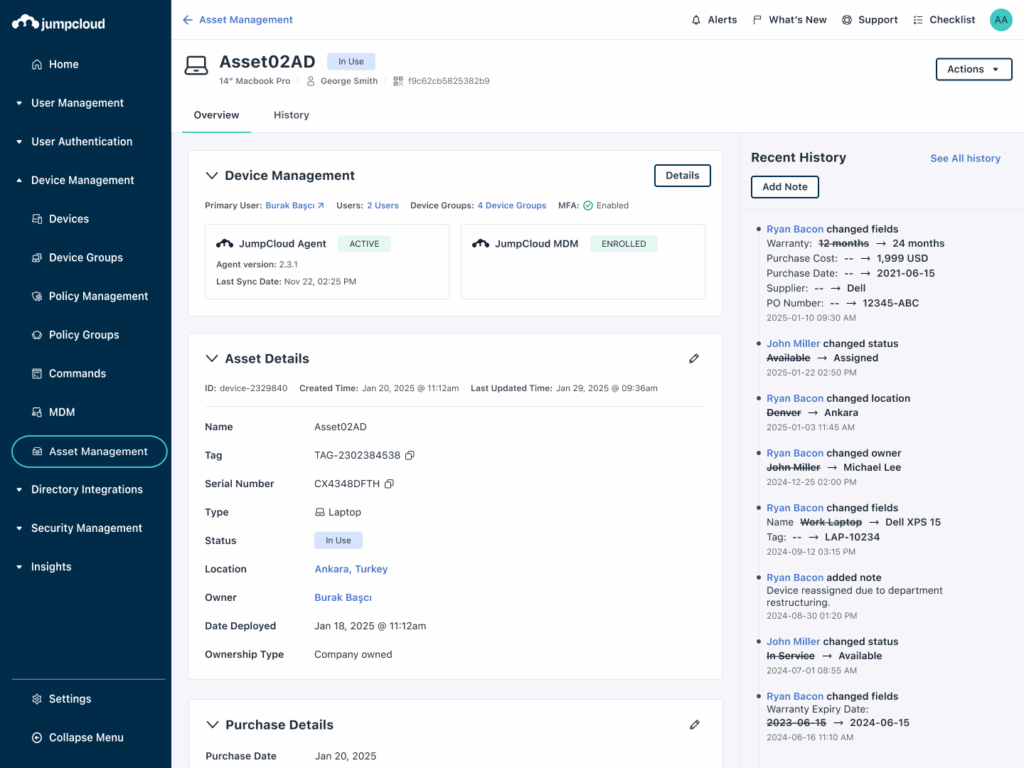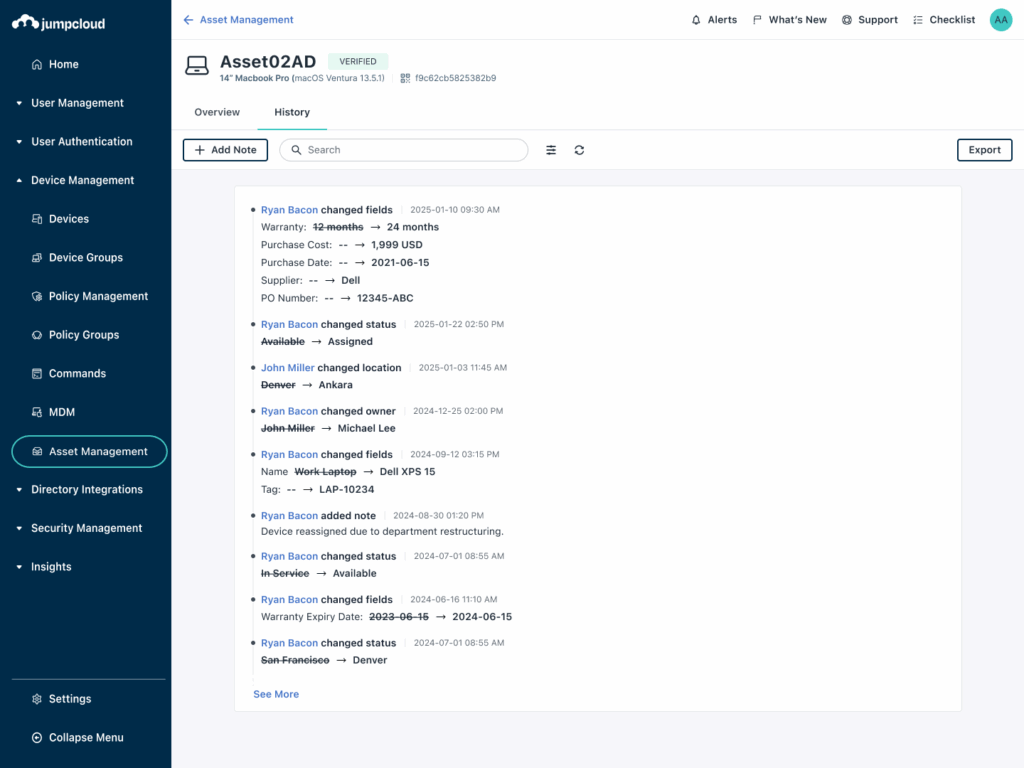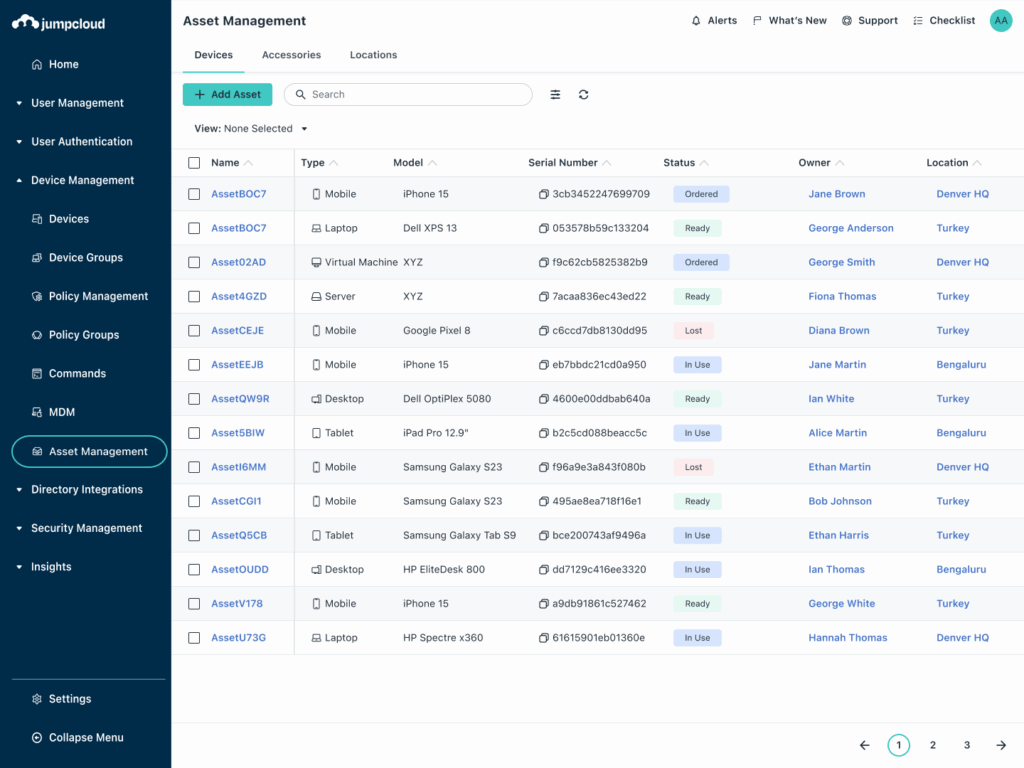IT teams today are under pressure to manage more technology than ever before. Devices are spread across offices, remote setups, and hybrid environments. Spreadsheets or outdated tools often cannot keep up, leading to incomplete records, compliance gaps, and wasted time. To meet these challenges, organizations need clear asset management practices that are reliable, efficient, and adaptable.
In this post, we will walk through the best practices for modern IT asset management, along with how JumpCloud supports IT teams in adopting them.
1. Automate Where You Can

One of the most significant challenges in IT asset management is the reliance on manual processes. Spreadsheets and fragmented data sources are notorious for becoming outdated the moment they’re created, leading to inaccurate records, compliance gaps, and wasted administrative hours. For IT leaders and managers, this is a critical operational risk.
Research shows that IT teams lose 29% of their working week to manual processes, such as updating spreadsheets. This statistic powerfully quantifies the time-saving benefit of automation.
Modern IT asset management flips this paradigm on its head by embracing automation. With JumpCloud asset management integrated directly into our device management platform, your assets can report their own status. Once a device is enrolled in JumpCloud, it automatically and continuously syncs critical data points, including:
- Hardware specifications: CPU, RAM, storage, and other key components.
- Operating system details: Version, build, and patch status.
- Serial numbers: The unique identifier for each device.
- System status: Last check-in time and other health indicators.
By establishing this automated, single source of truth, you eliminate manual updates and the human error that comes with them. This ensures your inventory is always current and audit-ready, providing a real-time, accurate snapshot of your entire hardware fleet.
2. Track the Entire Asset Lifecycle

Assets are never static. Ownership changes, devices move between offices, warranties expire, and statuses shift from active to retired. A major mistake is to manage assets as a simple snapshot in time. To effectively run a modern IT department, you need to track the entire lifecycle of every device, from procurement to retirement.
This approach provides the historical context you need to answer critical questions with confidence, such as:
- Who owned this laptop last year?
- When did we update the OS?
- Why was this device retired?
Poorly managed devices, especially those that are untracked or overlooked during offboarding, can become a security vulnerability. The global average cost of a data breach is approximately $4.9 million, a figure that emphasizes the financial risk of untracked assets.
JumpCloud asset management is designed with a full view of the asset lifecycle in mind. It provides a transparent, historical record for each device, so you can see its complete journey. This data gives you a deeper understanding of your fleet so you can:
- Plan hardware refresh cycles with precision.
- Budget effectively based on real usage.
- Reduce waste by identifying and reallocating underused devices.
- Troubleshoot device issues.
- Gain transparency and accountability during audits
3. Customize to Fit Your Organization’s Needs
Every organization tracks assets differently. What’s critical for one business—like warranty expiration dates—might be less important for another that focuses more on tracking department codes or cost centers. A rigid, one-size-fits-all system forces you to adapt your workflows to its limitations, which can make your inventory less useful.
An effective asset management solution should work the way you do. With JumpCloud’s asset management capabilities, you can create custom fields and flexible records to capture the exact details that matter most to your organization.
This flexibility ensures your system supports your existing processes, rather than forcing your team into a rigid structure. You can track key information relevant to your business, whether that’s:
- Financial data, like cost centers and purchase dates.
- Operational details, like physical location or assigned department.
- Support information, like warranty expiration or service history.
By tailoring your asset records, you make sure your inventory is not just a list of devices, but a powerful source of truth that aligns with your specific operational and reporting needs.
4. Make Migration Simple
For many organizations, years of valuable asset data are trapped in spreadsheets or aging legacy tools. The thought of migrating all that information to a modern system can feel overwhelming, but the process doesn’t have to be a major project.
JumpCloud makes it straightforward to centralize your data. It enables bulk CSV imports and API-based actions, making it easy to bring your existing information into our platform. This means your IT team can quickly consolidate both managed and unmanaged assets without the need to start from scratch.
Once your data is in the system, it’s easy to keep it current with minimal effort, ensuring your inventory is accurate and always ready to serve as your single source of truth.
5. Embrace a Modern, User-Friendly Approach
Today’s IT administrators expect their professional tools to be as intuitive and user-friendly as the apps they use every day. Asset management should feel like a core part of their workflow, not a chore.
JumpCloud’s approach to asset management is centered on a clean, logical interface. It’s built with features designed to simplify the IT admin’s job, including:
- Saved views to instantly access key reports.
- Simple exports for easy data sharing and analysis.
- Clear change logs to track asset history with a glance.
This focus on the user experience helps reduce the learning curve for new team members, encourages consistent use across the organization, and makes it simple to generate reports and pull insights quickly.
When a tool is easy to use, your team is more likely to keep the data accurate, making your entire asset management practice more effective.
6. Keep Reporting and Compliance Top of Mind
Even if compliance is not the primary driver, having easy, exportable reporting available is a best practice. It helps IT teams respond quickly to audits, share updates with leadership, or review status across departments.
JumpCloud supports reporting that includes ownership, location, and custom field details. These reports not only satisfy auditors but also provide valuable insights for strategic IT planning.
7. Think Beyond Laptops and Desktops

While computers are often the focus, IT asset management is most effective when it covers all types of technology assets such as mobile phones, tablets, printers, peripherals, and accessories.
By supporting a wide range of asset types, our solution helps IT maintain a complete picture of the organization’s technology footprint. This reduces the chance of lost, forgotten, or unaccounted-for assets that can add up to significant hidden costs.
Final Thoughts
Strong asset management is not just about keeping a list of devices. It is about creating a reliable, living record of an organization’s technology. By automating updates, maintaining historical visibility, allowing for customization, simplifying migration, and ensuring reporting and compliance are straightforward, IT teams can save time, reduce errors, and make smarter decisions.
JumpCloud asset management is designed with these best practices in mind. It replaces spreadsheets and fragmented tools with a centralized system of record that keeps pace with today’s dynamic workplace. Learn more about JumpCloud Asset Management.




